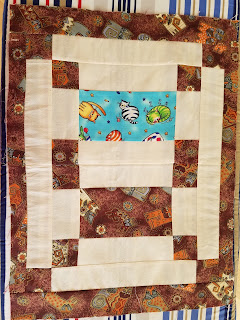A couple of finished items – one sewn, one knitted.
Way back in November last year, I posted
pictures of the quilt I made for my grandson. This meant I had to make a quilt for my granddaughter and I had to finish it quickly because she told me that I could not give him his until she had one. Even so, I still took about 5 months to come up with a completed project.
I had seen a quilt kit in Missouri Star Quilt Co. catalogue and as I had a charm pack and jelly roll (yes the last of the poor quality ones) I decided to make my own. I also decided to follow the procedures in Quilt as you Go Made Modern. There were advantages and disadvantages of this. The way Jera Brandvig works her quilt as you go, is to sew pieces onto batting squares then sew the squares together to make a quilt top and then add backing. The disadvantage of this method is all the fluff that goes into your machine from the batting and you still have to add some quilting on the whole quilt when you add the backing. I have seen a YouTube video by an Australian quilter who shows how to quilt as you go complete squares and how to join them. One day I will do that. (As an aside, I did clean my machine and change the needle when the quilt was finished.)
The pattern is a modified log cabin (off to google search to see if there is a correct name) and the advantage of Jera Brandvig’s method was that I felt each square had some stability and the quilting was easy but I did not like the thickness of each seam.

I needed fabric to tie all the squares together and purchased the green and the lilac, which are glittery butterflies, for the sashing and borders. Of course I changed my mind once I started sewing the squares and decided to have the lilac on just two sides of each square; my original plan was for each square to be bordered with the lilac. Changing my mind turned out to be a good thing because by the time I got to the binding, I didn’t have any fabric. I could not remember what my original plan was or if I even had had a plan. I did not want to use the backing fabric as it would have been too much of a contrast although I have plenty of it. (The quilt is more than one width’s of fabric.) I did not have enough of either the green or lilac fabric for the binding but by joining them together, alternating colour, I had enough and, I am sure you can agree, it works very well.
Both quilts were duly given to the children and appreciated.
I had a very small amount of the lilac fabric left and just over a very small amount of the green. So I made a bag.

By small amount you can see that I had to join the green and that there was just enough lilac to make the drawstrings. The pink lining you can just see was given to me.
The knitted item that I finished is the hat that I started as part of a KAL and I didn’t think I would finish in time. But I did and I am really pleased with that.

The yarn is Red Heart Soft – not the best yarn for colourwork but I wanted to use something where it didn’t matter what happened to the hat. I already had the Off White in stash and I purchased the Teal when it was on sale. I am mostly pleased with it. There was no row gauge given in the pattern and my hat was already to length when I had finished the snowflake. As it is a slouchy pattern it doesn’t matter that mine is a bit longer but I could have started the colour straight after the rib. As this is a pattern worked in the round, I do not like the way the pattern looks at the round join. Nobody else has mentioned this and I think it would have been less obvious if I had used a wool yarn. It does not show when the hat is worn.
And Ravelry. I mention Ravelry quite a bit in my blog because that is how I find most of the patterns I make. Either by searcing on Ravelry or because it has been mentioned by a friend or in a thread. Recently I listened to a podcast where the creators of Ravelry were
interviewed. It’s actually quite a long interview. This is not a podcast I listen to so I do not know if this is standard for her and I do not know if they have given other interviews of such length. I thought some of my readers might find it interesting.
(I have to confess though, the speech is interspersed with multitudes of “you know”s which drove me crazy.)







